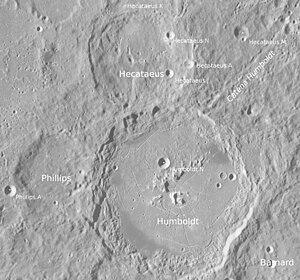Humboldt (moon crater)
| Humboldt | ||
|---|---|---|

|
||
| Humboldt and surroundings ( LROC -WAC) | ||
|
|
||
| position | 26.85 ° S , 80.76 ° O | |
| diameter | 199 km | |
| depth | 5160 m | |
| Card sheet | 99 (PDF) | |
| Named after | Wilhelm von Humboldt (1767–1835) | |
| Named since | 1935 | |
| Unless otherwise stated, the information comes from the entry in the IAU / USGS database | ||

Humboldt is a very large impact crater with a diameter of about 200 kilometers on the eastern edge of the front of the moon , between Mare Fecunditatis in the northeast and Mare Australe in the south. The smaller Hecataeus crater adjoins its northern edge and the Phillips crater at its western edge . The rim of the crater is heavily eroded and has terracing . The interior is largely level with a central mountain on which radial structures run.
The Catena Humboldt crater chain runs from the north-eastern edge of the wall in a north-easterly direction.
| Letter | position | diameter | link |
|---|---|---|---|
| B. | 30.77 ° S , 83.64 ° O | 21 km | [1] |
| N | 26 ° S , 80.64 ° E | 14 km | [2] |
The crater was officially named by the IAU in 1935 after the German linguist and politician Wilhelm von Humboldt . The Mare Humboldtianum is dedicated to his better-known brother, the natural scientist Alexander von Humboldt .
Web links
- Humboldt in the Gazetteer of Planetary Nomenclature of the IAU (WGPSN) / USGS
- Humboldt on The-Moon Wiki
- Spektrum.de : Amateur recordings [3]
Individual evidence
- ^ John E. Westfall: Atlas of the Lunar Terminator. Cambridge University Press, Cambridge et al. 2000, ISBN 0-521-59002-7 .
